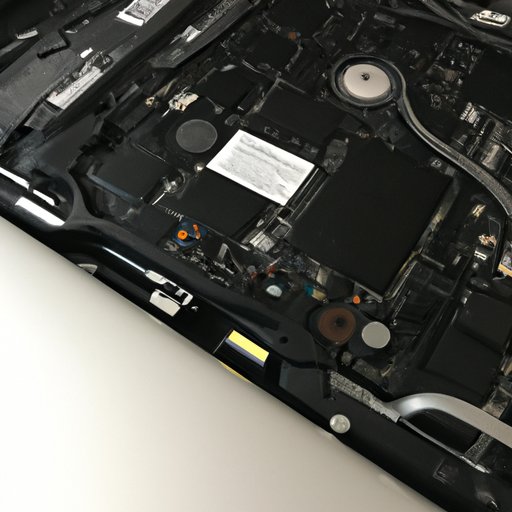I. Introduction
Have you noticed a significant decrease in your MacBook Pro’s performance, or do you need to pass it on to someone else? A factory reset may be necessary to wipe out all data and restore your system to its original state. This article will provide an easy-to-follow guide to help you reset your MacBook Pro without any complications.
We will cover everything you need to know, from requirements to troubleshooting, to make this process as smooth as possible. Whether you use the traditional approach or the new M1 Macs approach, we have got you covered. So, let us dive into the guide now.
II. Step-by-Step Guide
The following are the basic requirements that you need before you start the factory reset process:
- A backup of all your data
- Access to your Apple ID
- An active internet connection
Once you are prepared, follow the below steps to reset your MacBook Pro:
- Click on the Apple logo on the top left corner of your screen.
- Select the “Restart” option from the drop-down menu.
- Hold down the “Command + R” keys while your MacBook is restarting; this will boot it into Recovery Mode.
- Once you see the Utilities window, select “Disk Utility.”
- Click on “Continue” and select your startup disk from the list of disks.
- Click on the “Erase” button at the top of the window and wait for your system to erase all data.
- Once the process is complete, exit Disk Utility and proceed to reinstall the macOS by following the on-screen prompts.
There you go! Your MacBook Pro is as good as new.
If you own an M1 Mac, this is how you reset it:
- Shut down your MacBook Pro.
- Press and hold down the power button until the startup options appear.
- Click on “Options” and select “Reinstall macOS.”
Follow the on-screen prompts to reinstall the macOS and complete the reset process.
III. Video Tutorial
For those who prefer visual aids, we have included a video tutorial for you below. The visual content makes it easier to follow the steps without getting lost:
If you prefer reading instead, here is a transcript of the video:
“In this video, we are going to show you how to reset your MacBook Pro using macOS Recovery. Boot the MacBook Pro using macOS Recovery by holding down Command + R as soon as you switch on your MacBook. Once the MacBook is booted into macOS Recovery, you will be given four options:
- Restore From Time Machine Backup
- Reinstall macOS
- Get Help Online
- Disk Utility
Select “Disk Utility” and click on “Continue.” In the “Disk Utility” window, select the disk you want to erase. You can recognise it by seeing the type in “Internal” in the name of the drive. Click on the “Erase” button. You can give it any name you want, choose the “Mac OS Extended (Journaled)” format, and click “Erase” to start the process. Once the disk is erased, you can close the “Disk Utility” and click on “Reinstall macOS.” Follow the prompts to complete the installation.”
IV. Frequently Asked Questions
We have answered some commonly asked questions about factory resetting a MacBook Pro that might be helpful:
1. Will factory resetting delete all my data?
Yes. A factory reset will erase all data from your MacBook Pro. Ensure you have backed up all your important files in advance.
2. How do I back up my data before resetting?
You can back up your data in several ways, such as using iCloud, Time Machine, or third-party backup software. Apple’s Time Machine feature is an easy and effective method to back up your entire system.
3. Can I stop the reset process once it has started?
No. Once the process has started, you cannot stop it. Therefore, make sure to back up and double-check before initiating the process.
4. What steps should I take once I have reset my MacBook?
Once you have reset your MacBook Pro, you should set it up as a new device or restore it from a backup. This depends on what you’re looking to achieve.
V. Behavioral Tips
To avoid frequent factory resets, you should consider the following tips:
- Declutter your desktop and empty the trash bin regularly.
- Clear caches and temporary files regularly using tools like CCleaner or CleanMyMac.
- Do not overload your MacBook Pro with too much data storage.
- Manage your updates regularly; deferred updates could cause issues in the long run.
VI. Troubleshooting
Here are some common problems you might face during or after a factory reset:
1. My MacBook Pro is slow after resetting.
If your MacBook Pro is slow after resetting, try resetting the system management controller (SMC) and the parameter random access memory (PRAM). This will clear out any residual data and help your device run more smoothly.
2. I am getting an error message during the reset process.
If you get an error message, restart the reset process and follow each step carefully. If the problem persists, contact Apple Support for assistance.
3. I am concerned about my privacy.
You can ensure your privacy by encrypting your backup data and using a strong password. This will prevent anyone from accessing your data without your consent.
VII. Conclusion
We hope this step-by-step guide has been helpful in resetting your MacBook Pro. Remember to back up your data and take all necessary precautions before beginning the reset process. With the right preparations and knowledge, you can easily reset your MacBook Pro and have it working as good as new. If you encounter any issues, do not hesitate to contact Apple Support for further assistance.
